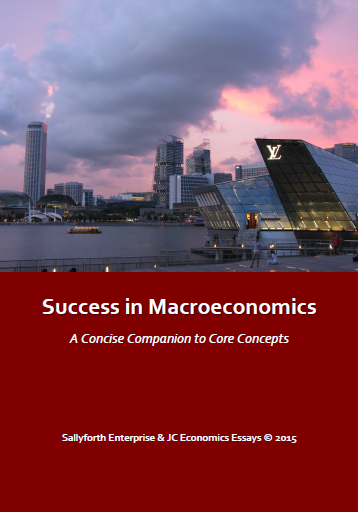In recent years, economists worldwide argued that
Discuss the implications of a revaluation of the Chinese yuan (RMB) on
Introduction
The
Chinese yuan (reminbi, RMB) has long faced revaluation pressures with China ’s mounting trade surpluses and developed
countries’ claims of China dumping
cheap goods on their markets, flooding their economies with low-priced goods “Made
in China
This paper argues that, as an increasingly dominant trading partner forSingapore , if China
were to revalue the yuan, it would have a huge impact on Singapore Singapore economy through
imports from China , exports
to China , and the
concomitant effects on the balance of payments, and may thus impact Singapore
This paper argues that, as an increasingly dominant trading partner for
Imports: Imported Inflation
First
and foremost, Singapore
imports a large variety of goods from China ,
as Singapore Singapore , the demand for these goods is relatively
price inelastic, and thus the revaluation of the yuan, which makes Singapore ’s imports from China more expensive, would likely raise Singapore
Most importantly, becauseSingapore
relies on Chinese inputs for production of both exports and also domestically
consumed goods, a revaluation of the yuan would result in imported inflation in
Singapore
Inflation is defined as a persistent and sustained increase in the general price level, and can be divided into demand-pull and cost-push inflation. In this case, cost-push inflation in terms of imported inflation would result from a revaluation of the yuan.
Most importantly, because
Inflation is defined as a persistent and sustained increase in the general price level, and can be divided into demand-pull and cost-push inflation. In this case, cost-push inflation in terms of imported inflation would result from a revaluation of the yuan.
Exports: Earning?
However,
on the other hand, Singapore ’s
exports to China Singapore dollar to offset the relative effect,
would result in Singapore ’s
exports to China China and their rising disposable income,
consumption of imports is rising in China ,
and Singapore
Yet, it has to be argued that the problem is thatSingapore depends heavily on imported inputs,
being a small and open economy, and as such it is likely that the increased
exports to China would be
less than the increased costs of imports, which are often needed to produce
output in Singapore Singapore
Yet, it has to be argued that the problem is that
Balance of Payments: Trade Deficit?
Therefore,
the revaluation of the yuan would worsen Singapore ’s
balance of payments, possibly causing a growing trade deficit with China , thus hampering the Singapore
The balance of payments refers to the accounting record of all monetary transactions between a country and the rest of the world, and can be classified into the different components of the current account, capital account, financial account, and (statistical) balancing item. There could be a trade deficit forSingapore
The balance of payments refers to the accounting record of all monetary transactions between a country and the rest of the world, and can be classified into the different components of the current account, capital account, financial account, and (statistical) balancing item. There could be a trade deficit for
Damage to Singapore’s National Income and
Growth
Furthermore,
as China is one of Singapore ’s emerging exporting market and
increasingly important trade partner, given Singapore ’s
economy as one being driven by trade, the revaluation of the yuan can affect Singapore
First, potential growth could be hampered due to the rising input costs from goods we buy fromChina
from Singapore Singapore
Furthermore, if Singapore’s exports are affected because unit costs have risen due to imported inflation because Singapore uses foreign inputs to produce exports, as argued earlier, then X might fall in the long run, and also cause actual growth to slow down. Hence, potentially a rise in the yuan could potentially and possibly lead to both lack of potential and actual growth forSingapore Singapore is small and open, the higher costs of
imported inputs from China
would have detrimental effects and as such, the revaluation of the yuan has
largely negative implications on Singapore
First, potential growth could be hampered due to the rising input costs from goods we buy from
Furthermore, if Singapore’s exports are affected because unit costs have risen due to imported inflation because Singapore uses foreign inputs to produce exports, as argued earlier, then X might fall in the long run, and also cause actual growth to slow down. Hence, potentially a rise in the yuan could potentially and possibly lead to both lack of potential and actual growth for
Policies and Conclusions
Since the
export sector of (X-M) takes up a huge proportion of Singapore ’s
national income because Singapore is a open and small economy, falling net export revenue from China
can potentially reduce Singapore ’s
rate of growth by shifting her AD to the left, unless this is cushioned by rising
export revenues with other trading partners, like the USA
However, that seems unlikely in the intermediate term given the global financial crisis and recent Eurozone crises and the concomitant recessions worldwide. Fortunately, as long as the Monetary Authority of Singapore allows an appreciation of SGD, ahead of the revalued yuan, the adverse impact of the revaluation onSingapore Singapore
In conclusion, the implications of a revaluation of the yuan on the Singapore economy are most likely negative overall, but Singapore has the appropriate policy tools in exchange rates and monetary policy to manage and mitigate these impacts and will use them if need be. Hence, to a large extent, the discretionary powers of the MAS would be useful in mitigating the effects of a revaluation in the yuan.
However, that seems unlikely in the intermediate term given the global financial crisis and recent Eurozone crises and the concomitant recessions worldwide. Fortunately, as long as the Monetary Authority of Singapore allows an appreciation of SGD, ahead of the revalued yuan, the adverse impact of the revaluation on
In conclusion, the implications of a revaluation of the yuan on the Singapore economy are most likely negative overall, but Singapore has the appropriate policy tools in exchange rates and monetary policy to manage and mitigate these impacts and will use them if need be. Hence, to a large extent, the discretionary powers of the MAS would be useful in mitigating the effects of a revaluation in the yuan.
Junior College Economics Essay: Tutor's Comments - This Economics paper was written and contributed by a Chinese student from China. This Economics essay has to be praised: first of all, it was composed and written under H2 JC Economics examination conditions; second of all, the language is good, refined, and proper; third, the content knowledge is there, and there is wide understanding of both the Singapore and the Chinese economies. There is good application of economics knowledge and concepts, and there are also empirical evidence and current affairs discussions. As an Economics tutor, this is one of the best Economics exam pieces that I have seen by a Chinese student, and it goes to show that when students work hard, study hard, and try their best, they can achieve, grow, learn, and develop rapidly. If they want to, they can put their heart into learning and studying Economics. As usual, do think of how you can improve upon this work and how you would approach this essay. Maybe, try to write out the answer without referring to this sterling Economics essay? It has also to be admitted that this Economics paper is (of course) not perfect: What other economics concepts, theories, and knowledge could you bring in to make the discussion richer? Thanks for reading and cheers.



